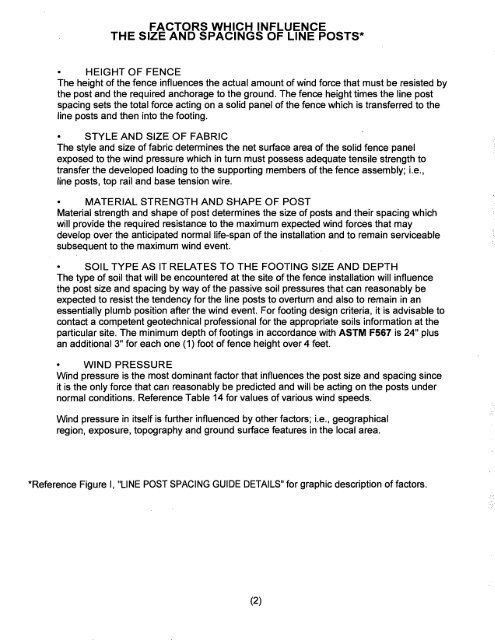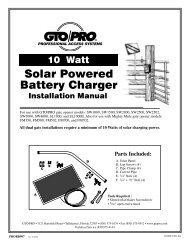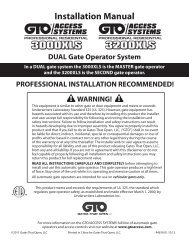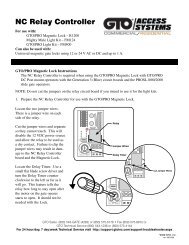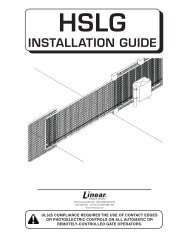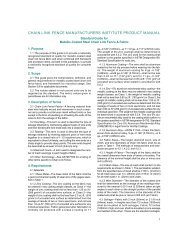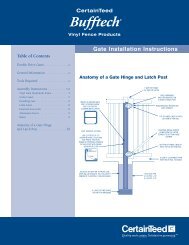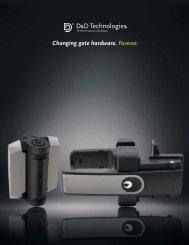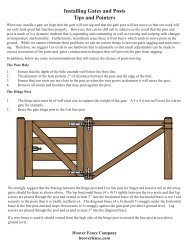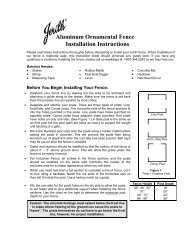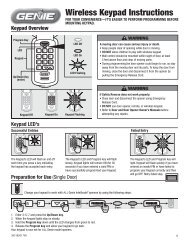Chain Link Fence Wind Load Guide for the ... - Hoover Fence
Chain Link Fence Wind Load Guide for the ... - Hoover Fence
Chain Link Fence Wind Load Guide for the ... - Hoover Fence
Create successful ePaper yourself
Turn your PDF publications into a flip-book with our unique Google optimized e-Paper software.
FACTORS WHICH INFLUENCETHE SIZE AND SPACINGS OF LINE POSTS*• HEIGHT OF FENCEThe height of <strong>the</strong> fence influences <strong>the</strong> actual amount of wind <strong>for</strong>ce that must be resisted by<strong>the</strong> post and <strong>the</strong> required anchorage to <strong>the</strong> ground. The fence height times <strong>the</strong> line postspacing sets <strong>the</strong> total <strong>for</strong>ce acting on a solid panel of <strong>the</strong> fence which is transferred to <strong>the</strong>line posts and <strong>the</strong>n into <strong>the</strong> footing.• STYLE AND SIZE OF FABRICThe style and size of fabric determines <strong>the</strong> net surface area of <strong>the</strong> solid fence panelexposed to <strong>the</strong> wind pressure which in turn must possess adequate tensile strength totransfer <strong>the</strong> developed loading to <strong>the</strong> supporting members of <strong>the</strong> fence assembly; Le.,line posts, top rail and base tension wire.• MATERIAL STRENGTH AND SHAPE OF POSTMaterial strength and shape of post determines <strong>the</strong> size of posts and <strong>the</strong>ir spacing whichwill provide <strong>the</strong> required resistance to <strong>the</strong> maximum expected wind <strong>for</strong>ces that maydevelop over <strong>the</strong> anticipated normal life-span of <strong>the</strong> installation and to remain serviceablesubsequent to <strong>the</strong> maximum wind event.• SOIL TYPE AS IT RELATES TO THE FOOTING SIZE AND DEPTHThe type of soil that will be encountered at <strong>the</strong> site of <strong>the</strong> fence installation will influence<strong>the</strong> post size and spacing by way of <strong>the</strong> passive soil pressures that can reasonably beexpected to resist <strong>the</strong> tendency <strong>for</strong> <strong>the</strong> line posts to overturn and also to remain in anessentially plumb position after <strong>the</strong> wind event. For footing design criteria, it is advisable tocontact a competent geotechnical professional <strong>for</strong> <strong>the</strong> appropriate soils in<strong>for</strong>mation at <strong>the</strong>particular site. The minimum depth of footings in accordance with ASTM F567 is 24" plusan additional 3" <strong>for</strong> each one (1) foot of fence height over 4 feet.• WIND PRESSURE<strong>Wind</strong> pressure is <strong>the</strong> most dominant factor that influences <strong>the</strong> post size and spacing sinceit is <strong>the</strong> only <strong>for</strong>ce that can reasonably be predicted and will be acting on <strong>the</strong> posts undernormal conditions. Reference Table 14 <strong>for</strong> values of various wind speeds.<strong>Wind</strong> pressure in itself is fur<strong>the</strong>r influenced by o<strong>the</strong>r factors; Le., geographicalregion, exposure, topography and ground surface features in <strong>the</strong> local area.*Reference Figure I, "LINE POST SPACING GUIDE DETAILS" <strong>for</strong> graphic description of factors.(2)


